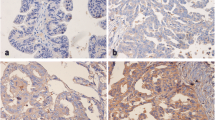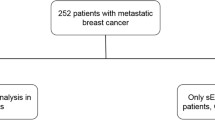Abstract
Purpose
Epidermal growth factor receptor (EGFR) plays an important role in the pathogenesis of multiple malignancies, and its expression also strongly affects the outcomes of cancer patients. The objective of this study was to determine the clinical significance of the serum levels of EGFR in epithelial ovarian cancer (EOC) patients.
Materials and methods
A total of 50 patients with a pathologically confirmed diagnosis of EOC were enrolled into this study. Serum EGFR levels were determined by the solid-phase sandwich ELISA method. Age and sex matched 20 healthy controls were included in the analysis.
Results
Median age of patients was 56.5 years old, range 22–83 years. Majority of the patients had advanced disease (FIGO stage III-IV) (90 %). No significant difference in baseline serum EGFR levels between EOC patients and controls (65.9 vs. 65.4 ng/mL, p = 0.86). Patients with normal CA 125 had higher serum EGFR level compared with the higher CA 125 level (p = 0.02). No other clinical variables including histology, stage of disease, and response to chemotherapy were found to be correlated with serum EGFR assay (p > 0.05). The patients with increased serum EGFR levels had poor progression-free survival than those with lower levels (median survival 4 vs. 12 months, respectively, p = 0.01). However, serum EGFR level was found no prognostic role for overall survival (p = 0.15).
Conclusion
Increased serum level of EGFR is associated with poor progression-free survival in EOC patients.



Similar content being viewed by others
References
Gui T, Shen K (2012) The epidermal growth factor receptor as a therapeutic target in epithelial ovarian cancer. Cancer Epidemiol 36:490–496
Lafky JM, Wilken JA, Baron AT, Maihle NJ (2008) Clinical implications of the ErbB/epidermal growth factor (EGF) receptor family and its ligands in ovarian cancer. Biochim Biophys Acta 1785:232–265
Baron AT, Cora EM, Lafky JM, Boardman CH, Buenafe MC, Rademaker A et al (2003) Soluble epidermal growth factor receptor (sEGFR/sErbB1) as a potential risk, screening, and diagnostic serum biomarker of epithelial ovarian cancer. Cancer Epidemiol Biomarkers Prev 12:103–113
Baron AT, Lafky JM, Boardman CH, Balasubramaniam S, Suman VJ, Podratz KC et al (1999) Serum sErbB1 and epidermal growth factor levels as tumor biomarkers in women with stage III or IV epithelial ovarian cancer. Cancer Epidemiol Biomarkers Prev 8:129–137
Baron AT, Boardman CH, Lafky JM, Rademaker A, Liu D, Fishman DA et al (2005) Soluble epidermal growth factor receptor (sEGFR) and cancer antigen 125 (CA125) as screening and diagnostic tests for epithelial ovarian cancer. Cancer Epidemiol Biomarkers Prev 14:306–318
Conflict of interest
None.
Author information
Authors and Affiliations
Corresponding author
Rights and permissions
About this article
Cite this article
Tas, F., Karabulut, S., Serilmez, M. et al. Increased serum level of epidermal growth factor receptor (EGFR) is associated with poor progression-free survival in patients with epithelial ovarian cancer. Cancer Chemother Pharmacol 73, 631–637 (2014). https://doi.org/10.1007/s00280-014-2396-x
Received:
Accepted:
Published:
Issue Date:
DOI: https://doi.org/10.1007/s00280-014-2396-x




